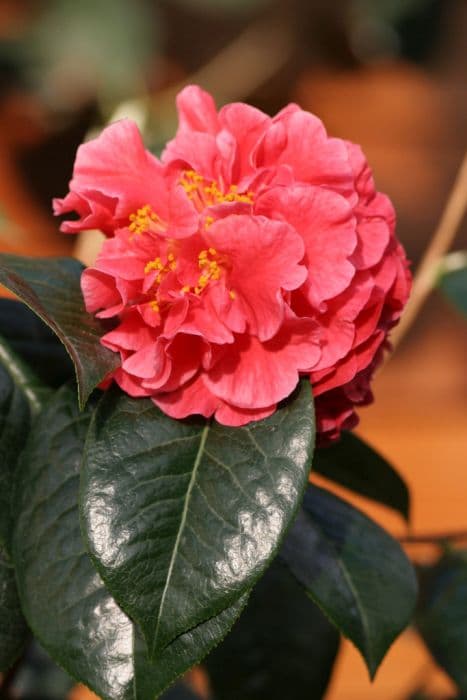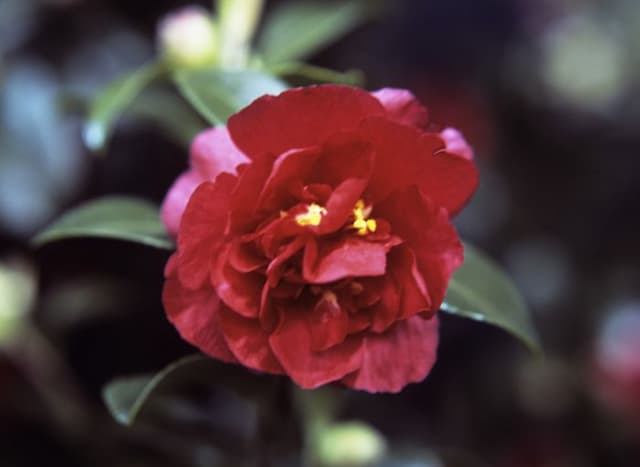Japanese camellia Camellia japonica 'Mars'

ABOUT
Camellia japonica 'Mars' is a striking flowering plant known for its lustrous, dark green foliage and vibrant floral display. The leaves are glossy, oval-shaped with a leathery texture and pointed tips, forming an attractive evergreen backdrop throughout the year. The highlight of this plant is its breathtaking flowers, which burst into bloom typically during the late winter to early spring season, depending on the climate. The flowers of 'Mars' Camellia are large and showy with a classic camellia form, boasting a multitude of petals that create a full and rounded appearance. Each blossom is a deep red color, exuding an air of elegance and romance in the garden. The petals have a velvety texture and may sometimes exhibit a slightly ruffled edge, adding to the ornamental appeal of the plant. The blooms are complemented by the plant's handsome foliage, making it a popular choice for ornamental gardens where year-round interest is desired. When not in bloom, the lush green leaves continue to provide a rich visual texture. This camellia variety can be a standout specimen in landscape designs, often used for hedges, foundation plantings, or as a focal point. Additionally, its flowers are highly coveted for cut flower arrangements due to their beauty and longevity. Overall, 'Mars' Camellia is a captivating plant that brings a touch of sophisticated color and graceful form to any garden setting.
About this plant
 Names
NamesFamily
Theaceae
Synonyms
Japanese Camellia, Camellia, Rose Of Winter
Common names
Camellia japonica 'Mars'.
 Toxicity
ToxicityTo humans
Camellia, known widely as Japanese camellia, is generally considered non-toxic to humans. There are typically no adverse effects experienced if someone ingests parts of this plant. However, as with any non-food plant, individual allergies or sensitivities could potentially cause mild stomach upset. It is always advisable to avoid ingesting plants that are not specifically grown for consumption to prevent any possible negative reactions.
To pets
Japanese camellia is considered non-toxic to pets such as cats and dogs. Ingestion of this plant should not cause any significant symptoms of poisoning in pets. Similar to humans, the natural defense mechanisms of pets might cause them to experience mild digestive discomfort if they consume non-food plants, but no severe toxicity from Japanese camellia is expected. If your pet consumes a large amount of any plant, monitoring for any signs of distress and consulting with a veterinarian is recommended.
 Characteristics
CharacteristicsLife cycle
Perennials
Foliage type
Evergreen
Color of leaves
Dark green
Flower color
Red
Height
6-10 feet (1.8-3 meters)
Spread
5-7 feet (1.5-2.1 meters)
Plant type
Shrub
Hardiness zones
7
Native area
Japan
Benefits
 General Benefits
General Benefits- Ornamental Value: Camellia japonica 'Mars' is highly appreciated for its large, attractive blooms that add aesthetic appeal to gardens.
- Landscaping Versatility: It can be used in a variety of garden designs, including formal, cottage, and woodland settings.
- Seasonal Interest: Blooming in late winter to early spring, it provides color and interest during a time when most other plants are dormant.
- Evergreen Foliage: The plant’s glossy green leaves offer year-round foliage, maintaining garden greenery even outside of the blooming season.
- Privacy Screen: With its dense growth habit, it can be used as a screen for privacy or to block undesirable views.
- Low Maintenance: Once established, it requires relatively low upkeep, making it suitable for gardeners of all skill levels.
- Durable: Camellia japonica 'Mars' is known to be a long-lived plant, often lasting several decades with proper care.
 Medical Properties
Medical PropertiesThis plant is not used for medical purposes.
 Air-purifying Qualities
Air-purifying QualitiesThis plant is not specifically known for air purifying qualities.
 Other Uses
Other Uses- Ornamental Topiary: Camellia japonica 'Mars' can be pruned and shaped into intricate topiaries for garden design and decorative purposes.
- Floral Arrangements: The blooms and foliage of the camellia can be used in floral arrangements to add elegance and color to bouquets and centerpieces.
- Photography Subjects: Due to their vibrant colors and shapes, camellia flowers are popular subjects for photographers, making them ideal for botanical art and educational materials.
- Wedding Decor: The romantic appearance of camellia blooms make them a sought-after choice for wedding decorations, including venue adornment and as part of the floral decor.
- Culinary Garnish: Though not commonly known for edibility, camellia petals can be used to garnish desserts and dishes for an added splash of color, provided they haven't been treated with chemicals.
- Dye Production: The petals of the camellia can be used to produce natural dyes for fabrics and crafting, yielding subtle shades of pink and red.
- Bonsai Art: Camellias can be trained as bonsai trees, allowing enthusiasts to enjoy their beauty in miniature form.
- Handcrafted Paper: The fibers from camellia can be incorporated into handcrafted paper, giving it a unique texture and appearance.
- Soil Erosion Control: Camellia japonica, when planted in groups, can help prevent soil erosion in gardens and landscapes due to their extensive root system.
- Festival Celebrations: In some cultures, camellia flowers are used in festivals as symbols of spring and beauty, featuring prominently in decorations and ceremonies.
Interesting Facts
 Feng Shui
Feng ShuiThe Camellia is associated with positive Feng Shui qualities such as bringing love, affection, and admiration when placed in the southwest area of a garden or home, or by the front door to invite positive energy. However, specific Feng Shui use may differ according to cultural interpretations and personal beliefs.
 Zodiac Sign Compitability
Zodiac Sign CompitabilityThe Camellia is not used in astrology practice.
 Plant Symbolism
Plant Symbolism- Admiration: Camellias generally symbolize admiration, respect, and affection for a person, making them a perfect gift to show appreciation.
- Perfection: Their lush, perfectly formed petals represent the ideal of beauty and perfection, suggesting that the recipient is without flaw in the eyes of the giver.
- Longevity and Faithful Love: Camellia japonica's ability to live for many years and bloom in the colder months leads to associations with long-lasting devotion and unwavering love.
- Humility: Despite their striking appearance, Camellias often symbolize humility, perhaps due to their tendency to let their beautiful flowers fall whole to the ground rather than fading petal by petal.
- Desire or Passion: The rich color of 'Mars' Camellias can evoke intense feelings of desire or passion, making them a powerful symbol for romantic emotions.
 Water
WaterThe Camellia, commonly known as the Japanese Camellia, requires consistent moisture, so water it when the top inch of soil feels dry. This typically equates to watering once per week, but frequency may need to increase during dry spells or hot weather. Apply water slowly, allowing it to soak deeply into the soil, which encourages root growth. It's best to use 1 to 1.5 gallons of water for each watering session to ensure the root zone is thoroughly moistened. During the winter, reduce watering but do not allow the soil to completely dry out.
 Light
LightThe Japanese Camellia thrives in partial shade with dappled sunlight. They perform best when protected from the intense afternoon sun, so a spot that receives morning light and afternoon shade is ideal. Too much direct sun can lead to leaf scorch, while too little light may reduce flowering.
 Temperature
TemperatureThe Japanese Camellia prefers temperate conditions and is hardy in USDA zones 7 to 9. They can generally withstand temperatures as low as 5 degrees Fahrenheit and as high as 85 degrees Fahrenheit but thrive in a range between 60 and 70 degrees Fahrenheit. Prolonged exposure to temperatures outside these ranges can stress the plant.
 Pruning
PruningPrune the Japanese Camellia to maintain its shape and encourage more robust growth, doing so immediately after flowering ends in spring. Remove any dead or damaged branches, thin out dense areas to improve air circulation, and shape the plant as desired. Pruning every year or two is often sufficient for this slow-growing shrub.
 Cleaning
CleaningAs needed
 Soil
SoilThe best soil mix for the Japanese Camellia is well-draining and rich in organic matter with a slightly acidic pH between 5.5 to 6.5. A blend of 2 parts peat moss, 1 part perlite, and 1 part pine bark is ideal, ensuring proper drainage and aeration.
 Repotting
RepottingJapanese Camellias should be repotted every 2-3 years in spring, before the growing season starts, using the soil mix specified for optimal health and growth.
 Humidity & Misting
Humidity & MistingJapanese Camellias thrive in moderate to high humidity levels, ideally around 40-60%. They benefit from a humid environment but do not require tropical levels of humidity.
 Suitable locations
Suitable locationsIndoor
Place near bright window, avoid direct sun, ensure high humidity.
Outdoor
Part shade, protect from afternoon sun, shelter from strong winds.
Hardiness zone
7-9 USDA
 Life cycle
Life cycleCamellia japonica 'Mars', commonly known as the Japanese Camellia, begins its life cycle when a seed germinates in moist, well-drained soil, producing a seedling. This young plant will then enter a vegetative growth phase, developing a sturdy root system and foliage through photosynthesis. As it matures, typically within a few years, the camellia will reach a reproductive stage, where it starts producing distinctive, large, and often red flowers from late winter to spring. Once pollinated, typically by insects, the flowers will develop into seed pods, which, when mature, open to release seeds, thus completing its reproductive cycle. Aside from seed propagation, the Japanese Camellia can also reproduce vegetatively through cuttings, which will root and grow into genetically identical copies of the parent plant. Over many years, with proper care, the Japanese Camellia can grow into a large shrub or small tree and continuously go through these growth stages, with seasonal dormancy periods typically in the colder months.
 Propogation
PropogationPropogation time
Spring-Early Summer
The Camellia japonica 'Mars', commonly known as the Japanese camellia, is most effectively propagated using semi-hardwood cuttings. This method is best carried out in late summer to early fall when new growth has begun to mature and harden slightly. To propagate by this method, cut a 4 to 6-inch (10 to 15 cm) long stem with several leaves, making sure to cut just below a leaf node. Remove the lower leaves to expose a node where roots can develop and dip the cut end into a rooting hormone to encourage root growth. The cutting should then be planted in a well-draining potting medium, such as a mix of peat and perlite. It is important to maintain a humid environment for the cutting, which can be done by covering the pot with a plastic bag or placing it in a propagator. Keep the soil moist but not waterlogged, and in a few weeks to months, the cutting should develop roots and can be transplanted into a larger pot or directly in the garden.









